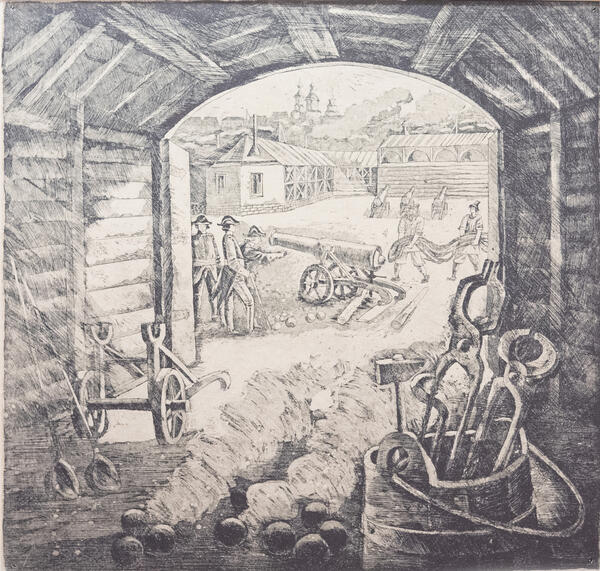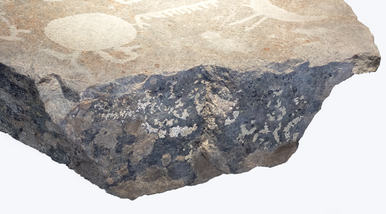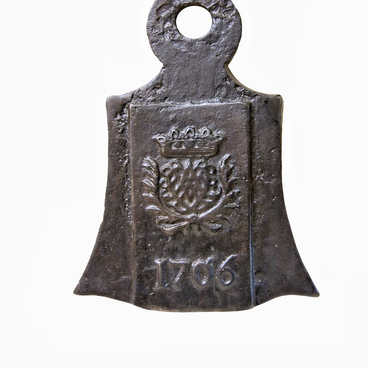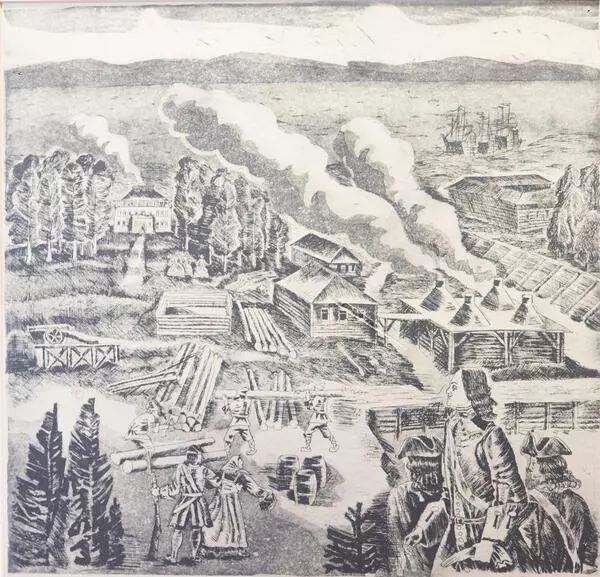Etching is a variety of printmaking based on intaglio print technique.
The etchings appeared in Bavaria, Germany in the 16th century. A Swiss jeweler and engraver Urs Graf was among the first artists to make them.
The etching technique was based on treating a metal surface with acid. This technique was adopted from jewelry work: the jewelers decorated expensive Damascus steel weapons in this way.
A polished zinc, iron or copper plate was coated with a thin layer of acid-resistant varnish for making an etching. This varnish was made on the basis of wax and resin or rosin and turpentine. When the varnish hardened a little, it was smoked for a while so that it would acquire darker color. Then the design was then drawn on the vanish layer with a special sharp tool — an etching-needle. The scratches had to penetrate the surface of the metal.
After that the plate was dipped in acid. A zinc plate was etched in nitric acid diluted solution and a copper plate was etched in ferric chloride solution. During etching, the etched lines were deepened; while the areas protected with vanish, remained unchanged. Then the varnish was removed and black typographic ink was spread into the incised lines. After that, the plate was covered with a slightly moistened paper sheet and rolled with a cylindrical printing press. The dampened paper soaked ink from the incised lines under the pressure and the etching’s design appeared in reverse of the original on the plate.
The etching “Artillery Craftsmen” from the National Museum of the Republic of Karelia collection was made by the artist and illustrator Boris Akbulatov. The “Artillery Craftsmen” (“Pushkari”) were foundrymen who cast cannons and cannonballs. In the foreground, there is a foundry shop interior: log walls, the arched ceiling, some forging tools in a bucket, and two ladles for metal casting. The workshop overlooks the factory yard where officers inspect a cannon.
Boris Akbulatov was born in 1949. The artist has been studying the history of Petrozavodsk and the city founder Peter the Great since 1977. In 1988, a book about Peter the Great “Medny Vershnik” (The Bronze Horseman) with Akbulatov’s illustrations was published. In addition, the Karelian artist depicted scenes of the local epic “Kalevala”, Pomorye life and his native nature.
In one of his interviews, the artist said,
The etchings appeared in Bavaria, Germany in the 16th century. A Swiss jeweler and engraver Urs Graf was among the first artists to make them.
The etching technique was based on treating a metal surface with acid. This technique was adopted from jewelry work: the jewelers decorated expensive Damascus steel weapons in this way.
A polished zinc, iron or copper plate was coated with a thin layer of acid-resistant varnish for making an etching. This varnish was made on the basis of wax and resin or rosin and turpentine. When the varnish hardened a little, it was smoked for a while so that it would acquire darker color. Then the design was then drawn on the vanish layer with a special sharp tool — an etching-needle. The scratches had to penetrate the surface of the metal.
After that the plate was dipped in acid. A zinc plate was etched in nitric acid diluted solution and a copper plate was etched in ferric chloride solution. During etching, the etched lines were deepened; while the areas protected with vanish, remained unchanged. Then the varnish was removed and black typographic ink was spread into the incised lines. After that, the plate was covered with a slightly moistened paper sheet and rolled with a cylindrical printing press. The dampened paper soaked ink from the incised lines under the pressure and the etching’s design appeared in reverse of the original on the plate.
The etching “Artillery Craftsmen” from the National Museum of the Republic of Karelia collection was made by the artist and illustrator Boris Akbulatov. The “Artillery Craftsmen” (“Pushkari”) were foundrymen who cast cannons and cannonballs. In the foreground, there is a foundry shop interior: log walls, the arched ceiling, some forging tools in a bucket, and two ladles for metal casting. The workshop overlooks the factory yard where officers inspect a cannon.
Boris Akbulatov was born in 1949. The artist has been studying the history of Petrozavodsk and the city founder Peter the Great since 1977. In 1988, a book about Peter the Great “Medny Vershnik” (The Bronze Horseman) with Akbulatov’s illustrations was published. In addition, the Karelian artist depicted scenes of the local epic “Kalevala”, Pomorye life and his native nature.
In one of his interviews, the artist said,







